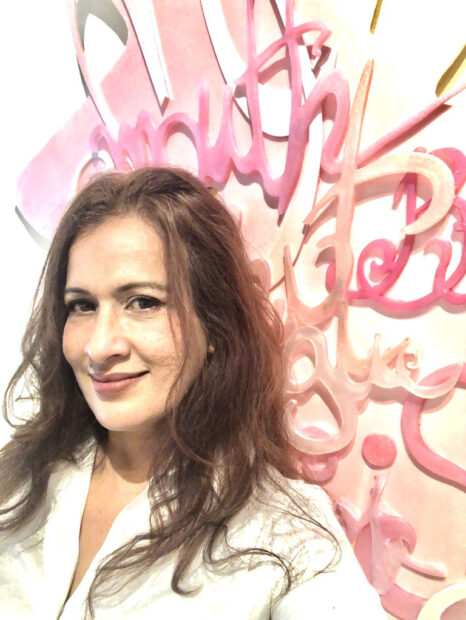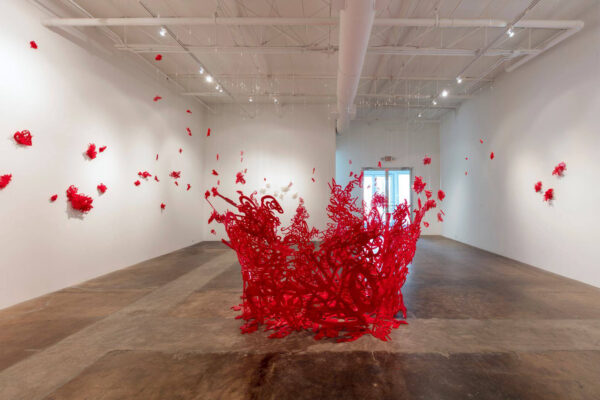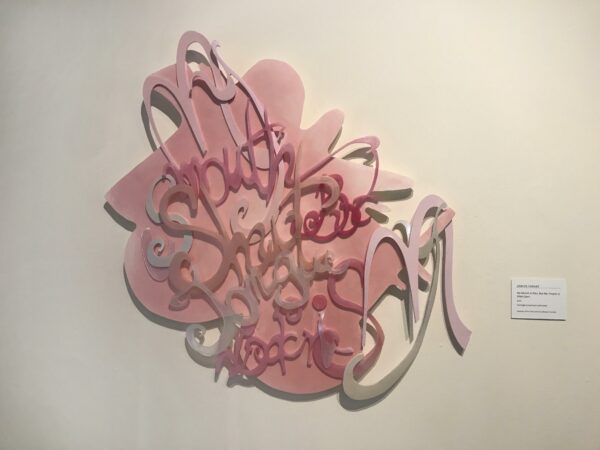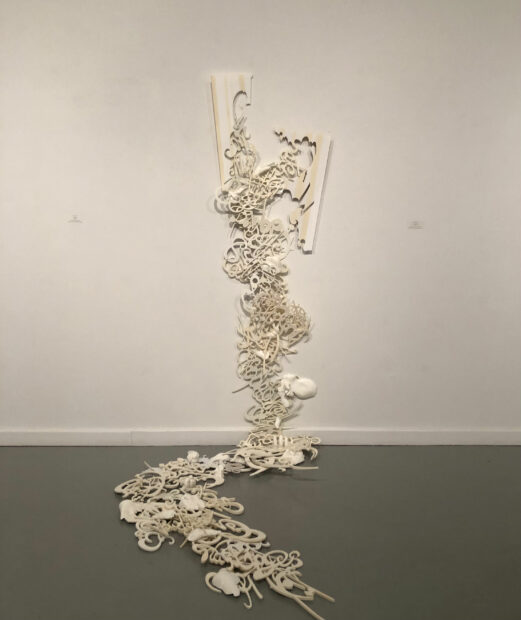
Simeen Farhat in front of her work “My Mouth Is Shut But My Tongue Is Wide Open.” Image courtesy of the artist.
Simeen Farhat is a Dallas-based artist best known for her cast-resin sculptures that combine words and letters into tangled, abstract forms. Born in Pakistan, she has resided in the United States for decades, a background that emerges in her work’s multilingual elements. Her work with language “just evolved,” she says, from her interest in gestural marks.
After viewing Farhat’s current exhibition, “Scripted,” at the Grace Museum in Abilene, I was curious about the various textual sources that inspired her, as well as the development of her process. Both aspects of her work have shifted over time from the traditional to the technologically mediated. We sat down to discuss her work in July.
Billi London-Gray (BLG): How did you start working with language in your artwork?
Simeen Farhat (SF): I was interested in the idea of the Tower of Babel, that languages evolve from one to another. I was interested in hieroglyphs and language as signs and symbols, and also Lévi-Strauss, structuralism, and Saussure. At first the works were illegible. They were representing a gesture, but it could be in any language. I wasn’t sure if I wanted to make my writing legible. I wondered, “What would be the context for that?”
It started to become legible when 9/11 happened. Then I started using a lot of political content. I was from Pakistan. I was living in Texas. I was reading a lot of news. I was taking text from headlines in Urdu and other sources and putting it together.
BLG: Were you responding to how the political stakes were raised by that event?
SF: Yes, I wanted to make things more explicit. I felt like I was living under the shadows of my identity. So, I started using silhouettes of myself, the shapes of my shadows, as if they were part of some language. I was using those silhouettes with text from newspapers and whatever else I was listening to and reading. And then it kept on evolving, and evolving, and evolving.
BLG: What was the next step from these silhouettes with text?
SF: This idea came to me about relating the human form and language. I made 3D figures that were hollow — no limbs, no facial features — but a head scarf and some text coming out of the hollow face, like babbling. These were showing thought processes. My idea was that you can contain the female form and body, covered and everything, but you cannot control people’s thought processes. The thought is still there, the idea, the freedom to think and speak. Even if you cannot speak in a public realm, your mind can still think, and you can still bring change in society. That was my breakthrough work.

Simeen Farhat, “Blood Shot Is Blood Loved,” 2017, acrylic, site-specific. Image courtesy of the artist.
BLG: Your work in the past decade has been more abstract. What changed in your use of the figure?
SF: It evolved into speech bubbles. The bodies sort of disappeared. I thought, do I need a body? Those speech bubbles became the shape and form. I started treating language as the elements and principles of design, more formally. Like, “This is the shape of the language.”
It was poetic, political, illegible, political, poetic, and was inspired by philosophy and literature. Alice in Wonderland inspired me to think about the nonsense of language. So I just started making those speech bubbles as jumbled up disarrays, where they had all the sense, but I didn’t want them to be legible. I didn’t want the viewers to go, “Okay, just read it, this is what it is.” I wanted it to be enjoyable as an art form.
The piece Ablaze is important. The poetry in it is about a candle’s flame and the energy it represents. All the language is legible. If you take apart the layers of words, you can read them. But the way I jumble them up, they are not readable.
BLG: How have you progressed through textual sources, from traditional poetry to emails and text messages?
SF: My father was very poetic. He inspired me. He would talk metaphorically using poetry. I was talking to him, metaphorically, when I started the 3D work.
But I didn’t force anything. Whatever is inspiring me at the time — that’s what I use. Text messages are ubiquitous, whereas poetry is more high. Not everyone is interested in poetry. But with poetry, text messages, email, or correspondence, it’s all communication. And with all communication, we misread and we misinterpret. It’s all people talking to each other and getting upset, saying, “No, this isn’t what you think.”

Simeen Farhat, “My Mouth Is Shut But My Tongue Is Wide Open,” 2021, cast pigmented resin, screws, 37 x 39 x 2.5 inches. Image by Billi London-Gray.
BLG: Your titles read like another level of wordplay to open up potential meanings. Can you talk about that?
SF: My titles can be a little poetic, which I like. I am playing with words. The piece Blue in the Shape of Teal kind of represents a peacock. I didn’t want to write poetry about a peacock, although the poetry related to that piece was about a bird. But I wanted it to kind of look like the thing.
The piece My Mouth Is Shut, But My Tongue Is Wide Open is a response to someone telling me, “You talk too much.” But there’s also a kind of intimacy, sexuality, and eroticism in that. Double entendre. Innuendo.
I’m Engulfed by My Shape is another example. Nowadays you ask for people’s pronouns and gender. People say, “I’m not what you see; you’re reading me wrong.” That piece was inspired by this idea, that there are genders that don’t depend on the shape of the body. But it could relate to worrying about your body, too.
The Black Sleep is based on a poem I wrote. It was about something that was everywhere. Something weird and uncanny, like bugs, everywhere and on everything. It got into my eyes. It got into my body and skin. It’s very dark, and it was inspired by Kafka and Baudelaire. I wrote that poem in 2015, and I made the piece in 2016. I did not make an eye, but abstractly there’s kind of an eye. When COVID happened, I was like, “Wow, that is exactly what I wrote about.” It’s a poignant piece right now. But on the more playful side, people always read the title as “The Black Sheep.” I enjoy that, and I always laugh.
BLG: Have you always written poetry?
SF: It came into my life recently. When I was younger, I would write silly things. There are people in my life who are writers and poets; they inspired me. I wouldn’t call myself a writer or a poet — I’m not. I’m still an artist. But I thought it might be to my advantage to write what I was thinking. I began writing what I would call art writings about food and things. I started writing out the idea for my projects like a prose poem, then I’d cut the idea out and make something from it.
BLG: That’s a good segue to discuss your process. Would you talk a bit about the importance of the gestural mark in creating your work?
SF: I love to draw. Those are my lines — it’s the gesture of myself. I treat those lines and shapes as my mark making. I take my forms, my language, my words, whatever I’m writing, and I exaggerate them. They could be in English, Urdu, German, Arabic, Persian, Hindi, Chinese, or Hebrew, but in all cases I draw them by hand. I’m just seeing text as a shape, and I’m trying to imitate the forms.

Simeen Farhat, “Bodies Hither and Thither,” 2021, cast resin, enamel, screws, site-specific. Image courtesy of the artist.
BLG: Can you walk me through your process for making a piece?
SF: I conceive of an idea. I do sketches. I have a text. And then I have this big form that I want the text — the individual words and letters — to fill. I draw those words and letters freehand with a pencil or pen. I either cut them myself or use CNC tools (I started out cutting everything myself in wood with a jigsaw). Then I make molds from the positive, and I cast in resin so I can control all the colors. Then I put the pieces together. The compositions are structured, but they are also a mix of control and chaos. If I give it too much structure, it loses some poetry. It loses the mark making, the gestural element.
I am forming all those letters and words from ideas. It’s not just taking any word and applying a process of abstraction, or going and buying words and letters somewhere and putting them together. They are not just abstract shapes. I have a thought process, and I’m giving that thought process a solid form.
BLG: You said you started cutting out shapes with a jigsaw. When did you start using CNC equipment?
SF: The CNC router is recent. I’ve also used some laser cutting. But really it’s just to get it cut faster.
BLG: How do you feel about technology as an interface for your mark making?
SF: It just saves my time. I’m not making the drawing digitally, that’s still by hand. Then I have to vectorize it. The way I work, it’s not that I just cut it out with a machine and snap it together. There are so many layers and steps I do by hand. That sets my work apart. My work is very involved.
BLG: Given all the layers of gesture and meaning you put into these compositions, is there a way you hope viewers approach your work?
SF: They can read it however. I cannot control how they see it. As long as they don’t always think it’s just arabesque. It really bothers me when people are lazy and just say, “Oh, it’s Arabic calligraphy,” when clearly you can see it’s English.
BLG: We’ve talked a lot about transitions in your past work. What’s next?
SF: I’m working towards combining mediums. I’m treating the language with a lot of different materials, giving it more meaning. And I am bringing in the human form again. The next series I’m working on is about body language. My idea is that the body is becoming a language. It’s evolving where language and body get mixed up. I’m using my own body. I could use models. Maybe there could be a performance. I may do big drawings. You know, when you move on to the next thing, you just keep working on something, then something else. It takes a year or two of exploring, but it comes.
Simeen Farhat’s solo exhibition, Scripted, is on view at the Grace Museum in Abilene through September 17, 2022.





1 comment
This is a great interview! Love reading about the different resources, techniques, etc.